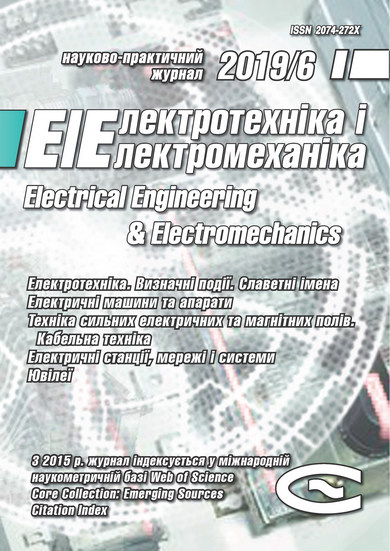A MATHEMATICAL MODEL OF THE ELECTRICAL ENGINEERING COMPLEX FOR DRIVE OF MAIN CIRCULATION PUMPS OF NUCLEAR REACTOR VVER-1000 OF NUCLEAR POWER PLANTS
DOI:
https://doi.org/10.20998/2074-272X.2019.6.02Keywords:
nuclear reactor, main circulation pumps, synchronous turbogenerator, transformer, induction motor, starting modes, self-starting, mathematical model, differential equationsAbstract
Tools for computer investigation of the modes of operation of induction motors of the main circulating pumps of the VVER-1000 NPP reactor have been created. The mathematical model of the electrical engineering complex «synchronous turbogenerator of NPP unit – electric grid of power system – two transformers of own needs – four induction motors» in phase coordinates, oriented on explicit methods of numerical integration of the system of differential equations is developed. On the basis of the mathematical model the software designed for the study of electromagnetic and electromechanical processes of the system of induction motors of the main circulating pumps of the VVER-1000 nuclear reactor in the modes of: operative switching including start and run, switching to standby power, self-start of the motors with turbogenerator’s run-out and without it is developed. The investigations of the processes in the system of induction motors in the mode of operative switching during their power supply from the turbogenerator are carried out and the basic regularities of their course in qualitative and quantitative relations are established.References
Baranov M.I. An anthology of the distinguished achievements in science and technique. Part 44: Traditional power engineering. Nuclear power stations: retrospective view, state and prospects of their development. Electrical engineering & electromechanics, 2018, no.3, pp. 3-16. doi: 10.20998/2074-272X.2018.3.01.
Topolnytskyi M.V. Atomni elektrychni stantsii [Nuclear power stations]. Lviv Polytechnic National University Publ., 2004. 562 p. (Ukr).
Shevchenko V.V., Kosmyn S.M. Features of work of drives engines technological pumps of reactor area of nuclear power plant. Transactions of Kremenchuk Mykhailo Ostrohradskyi National University, 2010, no.4(63), part 2, pp. 79-83. (Rus).
Feldman M.L., Chernovets A.K. Osobennosti elektricheskoi chasti atomnykh elektrostantsii [Features of the electrical part of nuclear power plants] Leningrad, Energoatomizdat Publ., 1983. 172 p. (Rus).
Plakhtyna E.H. Matematicheskoe modelirovanie elektromashinno-ventil'nykh sistem [Mathematical modeling of electric machine-valve systems]. Lvov, Vyshcha shkola Publ., 1986. 164 p. (Rus).
Vasyliv K.M. A mathematical model of thermal power plants smoke exhausters induction motors system operation modes. Electrical engineering & electromechanics, 2017, no.3, pp. 19-26. doi: 10.20998/2074-272X.2017.3.03.
Poliak N.A. Sovremennye krupnye dvukhpoliusnye turbogeneratory. Elektromagnitnye kharakteristiki [Modern large bipolar turbogenerators. Electromagnetic characteristics]. Moscow, Energiya Publ., 1972. 472 p. (Rus).
Fylts R.V. Matematicheskie osnovy teorii elektromekhanicheskikh preobrazovatelei [Mathematical foundations of the theory of electromechanical converters]. Kyiv, Naukova dumka Publ., 1979. 208 p. (Rus).
Kopylov I.P. Elektricheskie mashiny. [Electrical machines]. Moscow, Vysshaia shkola Publ., 2006. 607 p. (Rus).
Krause P.C., Wasynczuk O., Sudhoff S.D. Analysis of Electric Machinery and Drive Systems. IEEE Press, 2002. 632 p.
Downloads
Published
How to Cite
Issue
Section
License
Copyright (c) 2019 K. M. Vasyliv, L. I. Mazurenko

This work is licensed under a Creative Commons Attribution-NonCommercial 4.0 International License.
Authors who publish with this journal agree to the following terms:
1. Authors retain copyright and grant the journal right of first publication with the work simultaneously licensed under a Creative Commons Attribution License that allows others to share the work with an acknowledgement of the work's authorship and initial publication in this journal.
2. Authors are able to enter into separate, additional contractual arrangements for the non-exclusive distribution of the journal's published version of the work (e.g., post it to an institutional repository or publish it in a book), with an acknowledgement of its initial publication in this journal.
3. Authors are permitted and encouraged to post their work online (e.g., in institutional repositories or on their website) prior to and during the submission process, as it can lead to productive exchanges, as well as earlier and greater citation of published work.





